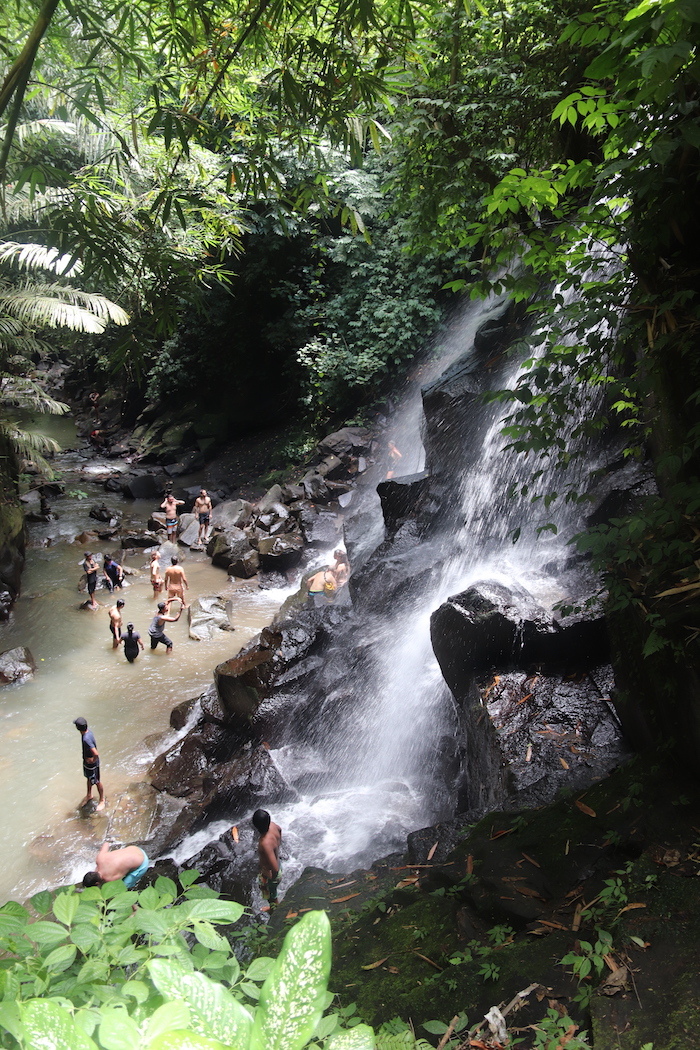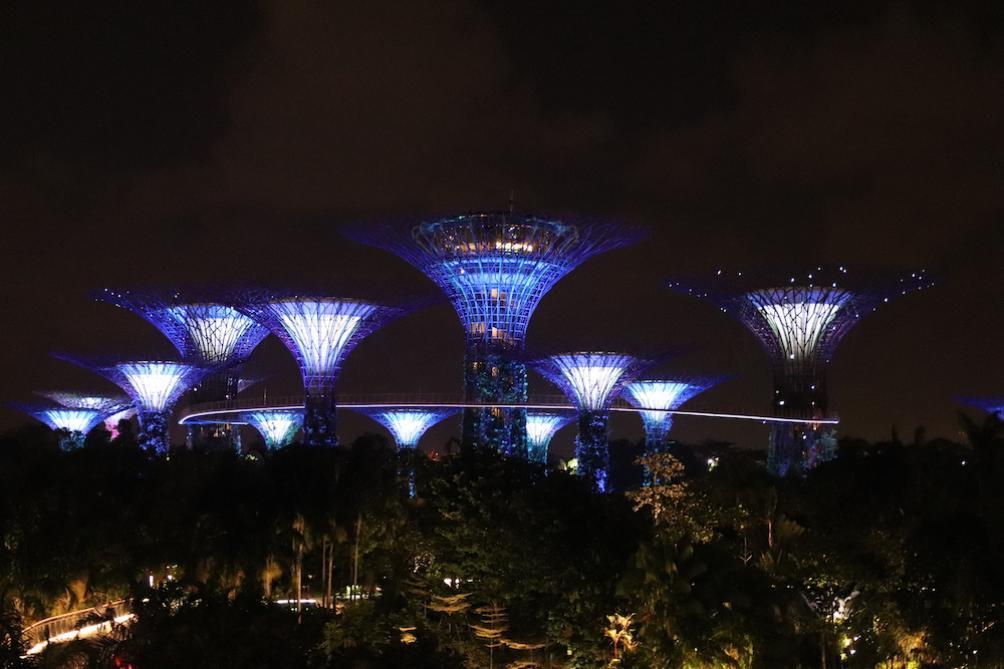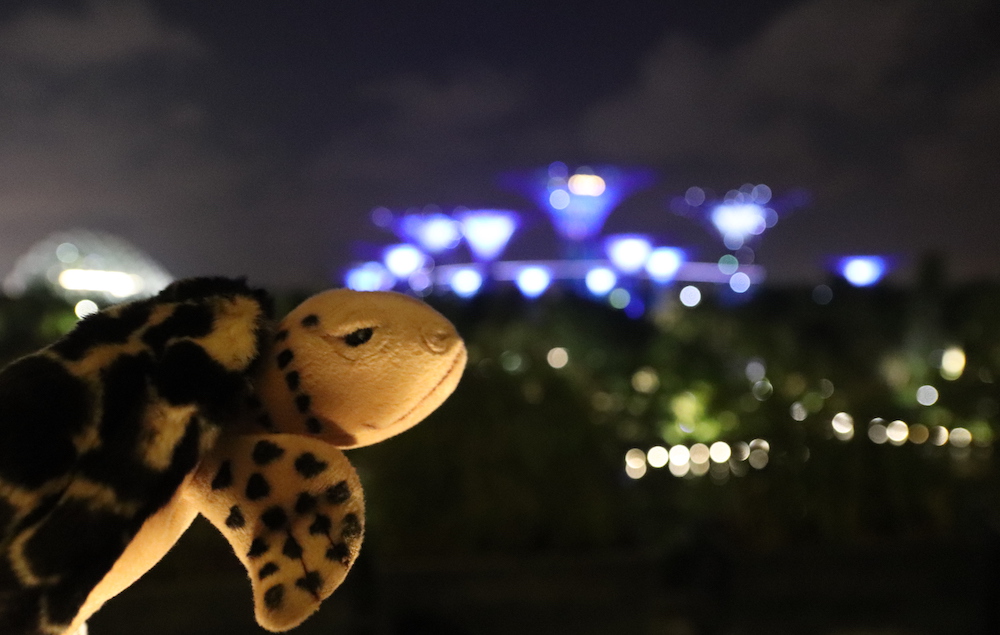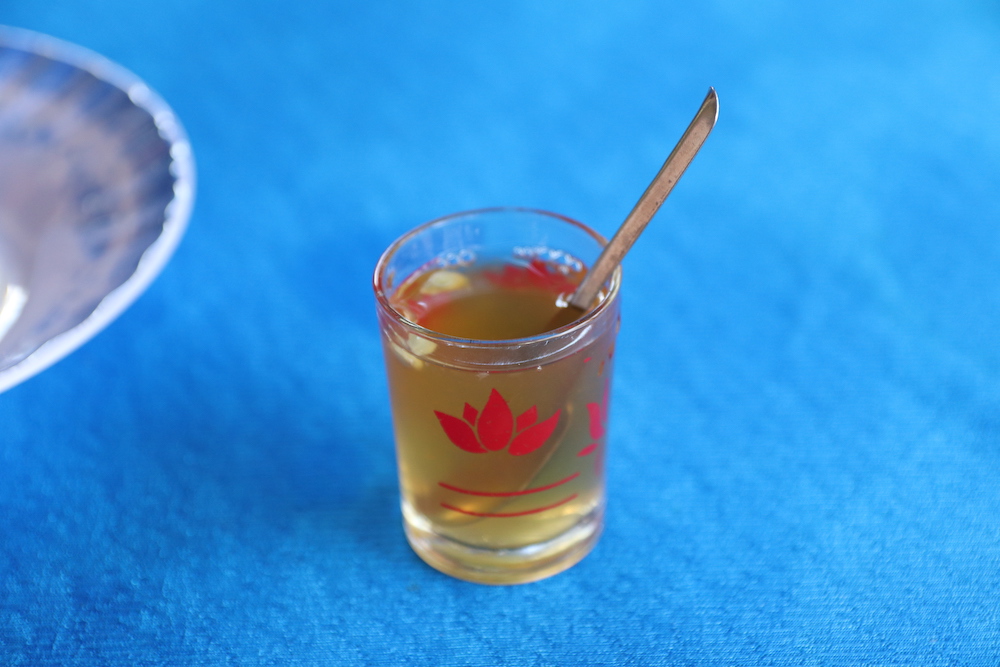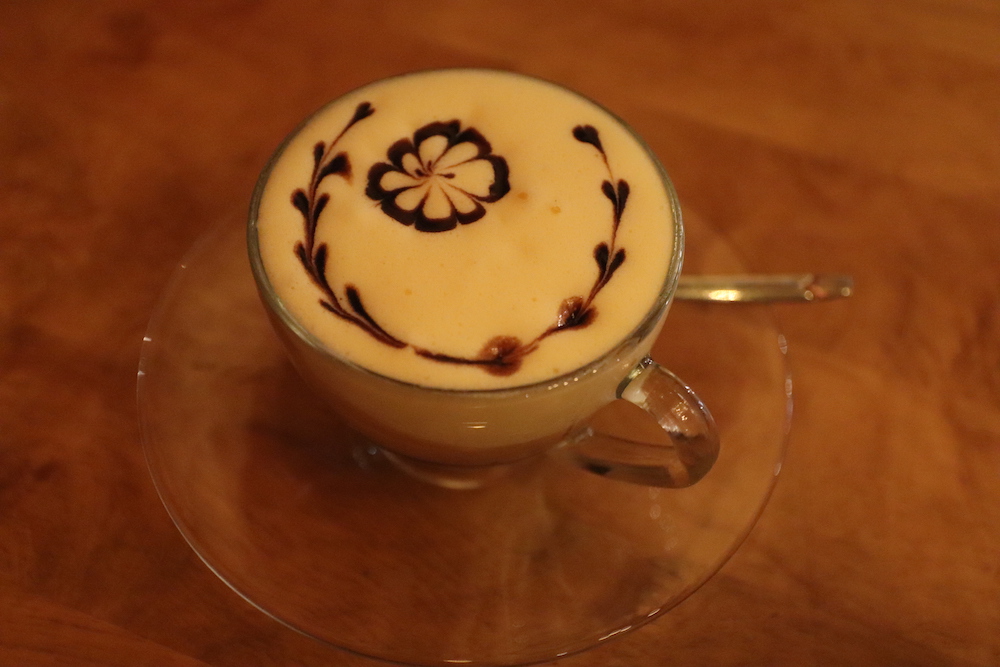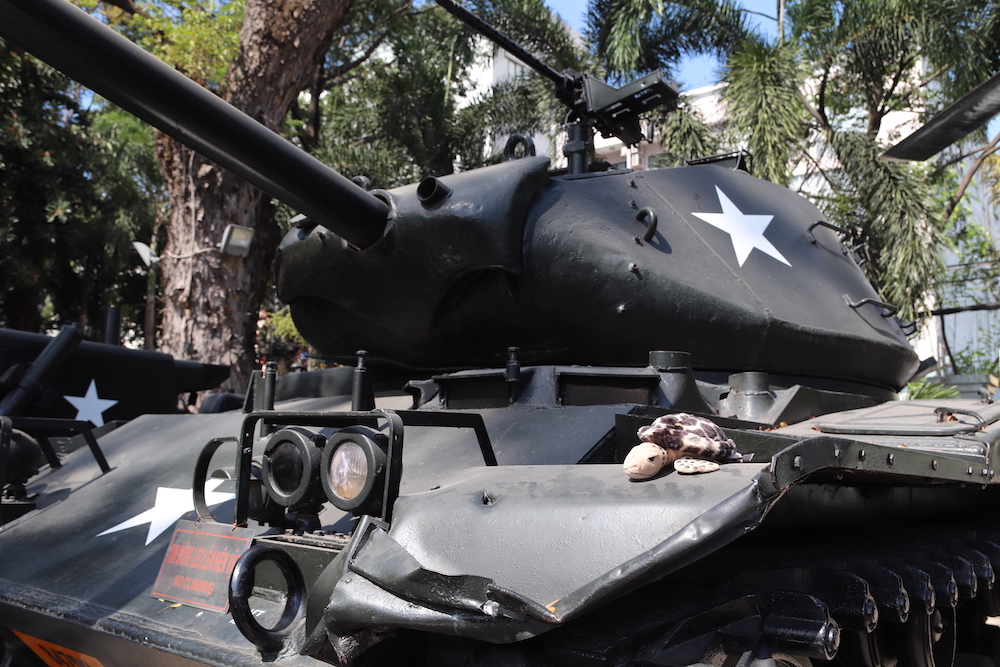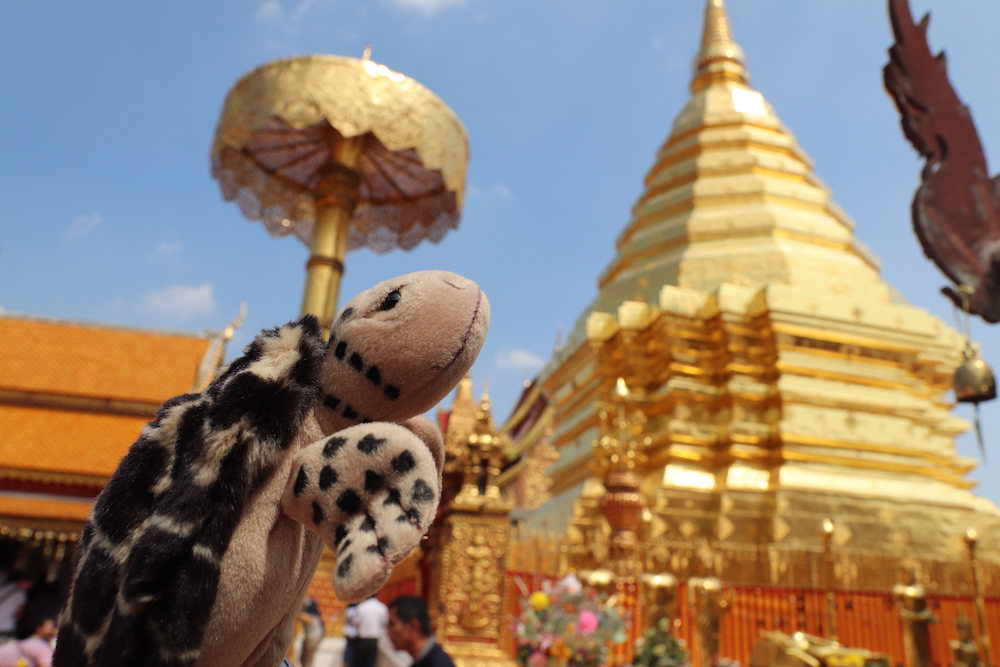Travel Blog II: Surfing and Swimming with Elephants
We woke up around 3.30am on the day we left the Philippines (something we were beginning to get used to), and with our arrival in Bali scheduled for around midnight, it looked like we were in for a fairly long day of travelling.
I actually quite enjoy flying, it's just the waiting around in airports that takes the energy out of me, having nothing better to do than look at screens and eat overpriced food. We spent pretty much the whole day like that, but it was still worth it. As night fell, we boarded our final plane to Bali, Indonesia, passing through a lightning storm along the way.
We caught up on sleep the next morning, only heading out for the beach around mid-day. It was a little windy, but warm. We spent that day relaxing on the beach, watching the surfers as the sun set. Admittedly that's how we spent most of our time in Bali. Looking back, I don't think I could have spent it any other way.
Bali is one of those places that’s been almost entirely taken over by the tourist industry. The island’s culture, cuisine and beaches attract travellers from all over the world, especially Australians, whose proximity to the island makes it incredibly affordable and accessible for a quick holiday.
Bali was also the first place we'd arranged to meet some of the other scholars who were also travelling around Asia. The biggest group had hired a villa at the other side of the beach from us. Although a little more expensive than a hostel, they each had a lot more space to themselves, along with their own private pool and hot tub. We were all invited for a barbecue and pool party that night.
Catching up with everybody was really refreshing. Having been used to seeing each other every day in class, the two weeks apart meant we actually had something a bit more interesting to talk about beyond everyday life. Seeing as we were still on our way to all of the places they had been, it was interesting to hear what they had made of each city, the best things to do, and what we were better off avoiding. We stayed up late, ending up around 2am with a few of us left in the pool talking about what we were going to do for the next few days. We settled on surfing, arranging to meet at the beach early the next morning to catch the morning waves.
We did not meet at the beach early the next morning.
Maybe it was just the late nights, or leftover tiredness from travelling, but we ended up sleeping in really late that day. Although we missed the best waves, just a little extra sleep went a long way in reenergising everybody. Besides, when learning to surf for the first time, I think you want to come prepared.
Kayleigh, having already made friends with a surfing instructor, had managed to half the price for each of our surfing lessons to just 100,000IDR (including 3 hours of board hire). This provided us with an hour's training and an entire afternoon of surfing for somewhere around £5. I thought that was a pretty good deal. Our instructors handed us some long sleeve t-shirts to protect from abrasion, then laid out our boards along the beach so we could practice the moves and positions for when we were actually in the water. They made it very clear that we had to get up as quickly as possible when standing up on the board; miss your chance and you’ll just be thrown back into the water again (or riding on your belly all the way to the beach, not a cool look by the way). Once confident that we'd mastered the basics, they decided it was time to head out to sea.
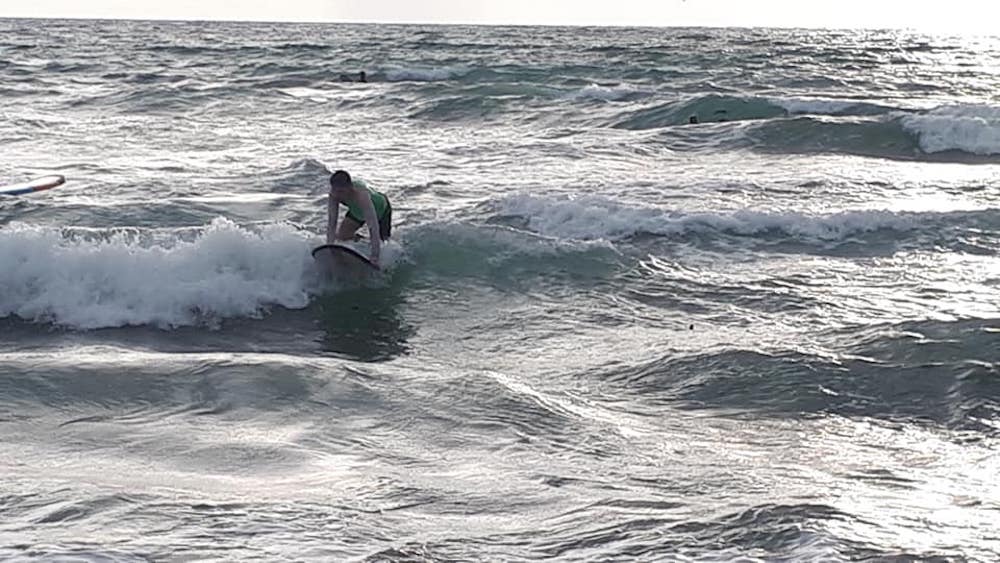
Surfing in Bali
The water felt cool after being in the sun all morning but it was still fairly warm, a whole lot more comfortable than the North Sea when all you’ve got is your swim shorts. As with on the beach, it was just a matter of putting my feet in the right place as quickly as I could in order to stay on top of the board. After an hour or so of flailing around trying to find the right position, I was standing. Sure, maybe I wasn’t going very fast and couldn’t really steer, but the feeling was amazing, I think it’s about as close as you can get to actually walking on water.
Our time in Bali passed by quickly, but on our last day we managed to hire out a minibus and took a tour around the island, checking out the best waterfalls, rice fields and small towns Bali had to offer. I got to try “kopi luwak” at a local coffee farm, known to be the most expensive kind of coffee in the world (I think I’ll leave you to google the reason why though). We ended our tour at a café by some clifftops to watch the sunset. As night fell, we gathered together for some final pictures of everybody together, before heading back to the hostel and packing our bags for Singapore.
Waterfall in Ubud, Bali
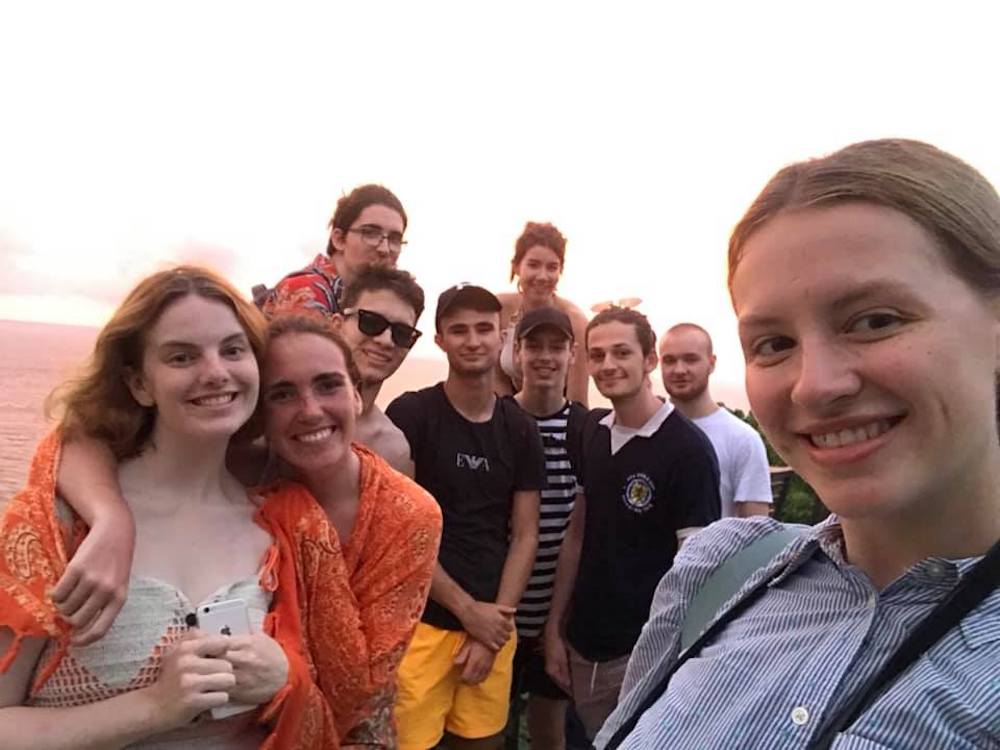
Sunset on last night in Bali
Due to the time of our flight the next morning, we didn’t actually bother trying to get much sleep that night. A couple of hours after getting in the door and putting our bags together, we were on our way out. The flight was fairly quick however and before long we were standing in sunny Singapore.
After getting our tourist pass cards (for unlimited use of public transport) we set off for our hostel and got checked in. As it turned out they offered a free all-day breakfast bar (which included Nutella), so although it probably wasn’t the healthiest way to save on food costs, we did manage to cover a lot of meals with it. Now somewhat reenergised from the Nutella after a sleepless night, we set off to explore the surrounding area a little.
Singapore is an incredible city. Everywhere you go, you look around thinking you’re in a future concept design with everything perfectly mapped out and people in all the right places. As Singapore has been rated as the world’s smartest city and world’s safest country, it may come as no surprise that it’s also the most expensive, with rent for a small apartment averaging at well over £1000 a month. That said, if you’re travelling through Singapore on a budget, it’s still possible to live fairly cheaply.
As well as most of the main attractions being either free or cheap to enter, many of the street food stalls and restaurant streets are more affordable than they look. In fact, Singapore is home to yet another “cheapest Michelin star restaurant in the world” (though this title should probably belong to the restaurant we went to in my last blog) with a small restaurant in Chinatown serving a chicken and rice dish for around £3. Unlike Tim Ho Wan however, I think you pretty much get what you pay for with this restaurant.
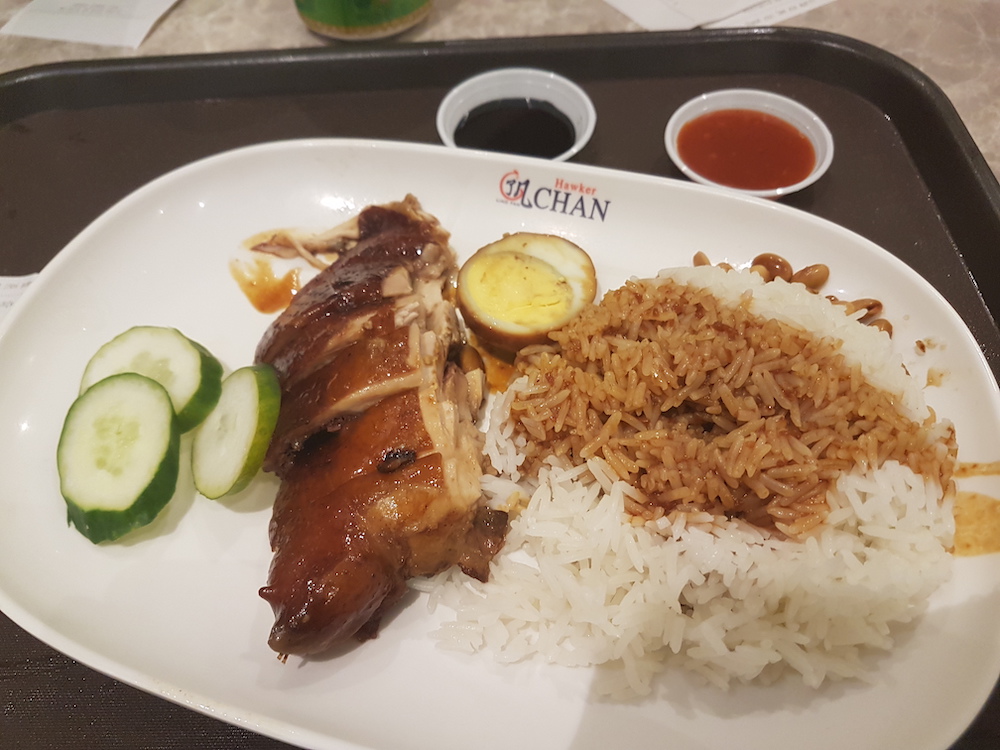
The Cheapest Michelin Star Meal in the World
Almost full on chicken and rice, we left to go and check out the main sights around Singapore. First, the National Museum, where we learned a bit about the history of the island, before circling around to the bay front at night, taking a quick look at the Gardens of the Bay before heading back and getting something a little more substantial for dinner.
The Gardens of the Bay
Sheldon at the Gardens of the Bay
On our last day in Singapore, we decided to go check out a local breakfast dish called “ya kun kaya”, a kind of toasted sandwich with a butter and coconut syrup filling served alongside a runny poached egg. It took a little getting used to, but once you got familiar with the mix of textures, it turned out to be really good. I don’t think I could have it every morning, but given another chance to visit Singapore, it would definitely be on the list of things to try again. On our way back to the hostel, we noticed a group of tourist-like foreigners going in and out of a mosque just down the road from us. The building looked pretty cool and we had plenty of time on our hands, so we decided to go take a look. Just inside the door were a few information boards explaining the basics about Islam, along with a few misconceptions about the religion. It was all pretty interesting as it wasn’t really something I’d looked into before.
I think one of the best parts of backpacking is getting a chance to sample culture from a number of countries besides the one you are actually visiting. I think this is especially true for Singapore. Having been a historic port and a common stopover point for travellers passing through Asia for centuries, the city does its best to accommodate people from all over the world. In fact, one of my most memorable meals from Singapore was actually a curry from Little India. The culture had carried over so well that everyone eating in the restaurants there even ate with their hands.
Before leaving Singapore, we decided to take a look up the Marina Bay Tower, a colossal three-legged building at the edge of the island overlooking the port. In order to avoid the hefty ticket price, we decided to go to the cafe on the second highest floor and buy something there instead. Unfortunately, I think they might have planned for this beforehand, considering that the cheapest thing on the menu was around £9. The view was spectacular though, so we stayed and footed the bill, and in the end it was worth the extra money anyway.
Our flight the next day was in the afternoon, so we managed to get a little sleep this time. After a quick breakfast, we set off for Changi Airport and to be honest, I was a little excited for it. I know I said earlier that I’m not a big fan of waiting around in airports, but this one was a little different. Singapore Changi Airport has been rated the best airport in the world by Skytrax for 7 years running. The place has its own cinema, shopping centre and indoor public park with the largest indoor water fountain in the world. Unfortunately, we had a flight to catch so we didn’t have much time to look around, but we did manage to catch some interesting features. Instead of being right after check-in, you go through security at each individual gate, so you don’t have to get rid of your water or fuss with bags until you’re actually ready to board your flight. It’s a nice touch, but it does take up a lot of space. The airport’s floor area is over 1,000,000m2, that’s around 150 football pitches.
We arrived at Ho Chi Minh in the early afternoon and met up with Arran for some traditional Vietnamese “phở”, a special kind of noodle soup. I had a little Vietnamese money that I’d exchanged in China but still had to find an ATM to pay for the hostel. Due to the differences in currency, as soon as I got my money I became an instant multi-millionaire, even though I’d only taken out around £100.
Before we met Arran, he’d already been through the autonomous region of Tibet, so he had plenty of stories to share from his travels. It was really interesting to hear his perspective on this far removed, distant part of China. Although it was the same country that we’d been living in for a few months, he compared the culture shock of going between Tianjin and Lhasa to that of Scotland and Tianjin. We went to a nearby cafe and exchanged stories over some Vietnamese egg coffee. We booked a bus tour along the Mekong Delta for the next day.
I slept for most of the journey, waking up among the rivers and trees of the country, a far cry from the bustling city I’d fallen asleep in. This was more like the Vietnam I’d pictured in my mind. Thick trees, grasslands and winding rivers all ran alongside a winding road. Our tour included a few boat rides between the islands along the river, where we got to see the culture of the people we visited and try some local food. Our tour guide told us to keep our hands inside the boat in case of crocodiles, but I didn’t see any.
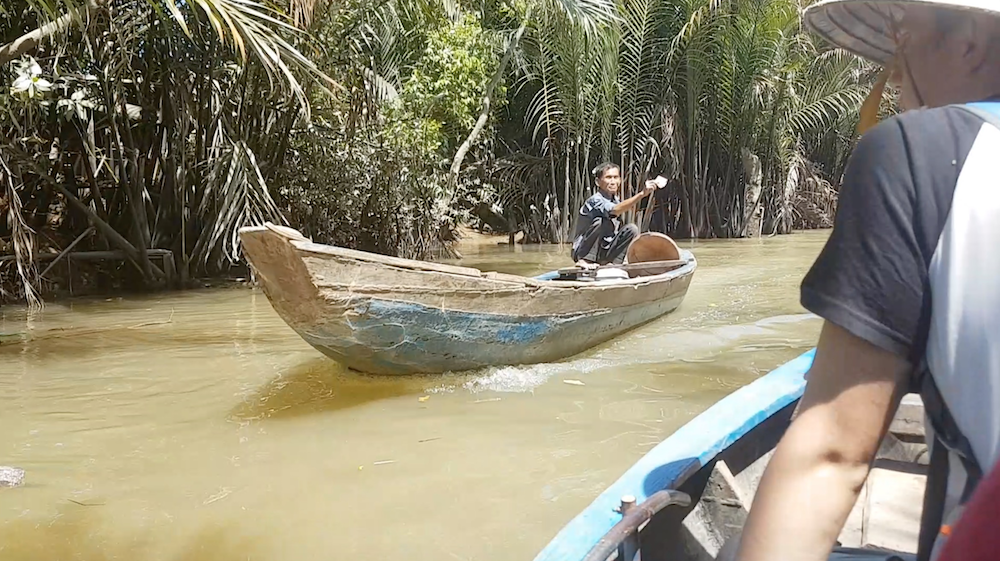
Sailing down the Mekong Delta
On one of the islands there was a small community of bee farmers cultivating a special kind of royal jelly, they proudly presented us with a small sample along with an exhaustive list of all the health benefits. Try as I might, I couldn’t think of any illness that wasn’t on the list, therefore having drunk the sample I can only assume I am now immortal. We visited a few other islands and saw some Buddhist temples before returning to the city in the evening to try and find some dinner.
All curing royal jelly
Vietnamese Egg Coffee
The next day we visited a museum to learn about everything that happened in the Vietnam War. It’s not something I’ve really looked into before, so I didn’t know what to expect. I have to say though, it’s not for the faint of heart. The lower floors focussed on the more political aspects of the war, the lead up and worldwide response. The floors above focussed on what actually happened during the war itself.
Despite Vietnam’s rich culture and complex history, it’s almost impossible to avoid seeing remnants of the war, especially in areas of tourism. This does make sense of course, Vietnam’s world image has basically been shaped by the war, and I think tourism tends to follow expectations. Having seen the country for myself though, I now know it’s far more than the image recent history has created for it.
Sheldon at the War Remnants Museum
Vietnam’s economy is currently one of the fastest growing in the world, and at time of writing, is even ahead of China in terms of GDP growth. Their food, culture and attractions are some of the most interesting I’ve come across during my whole time in Asia, and its people are just as friendly. I can tell they are eager to move away from the image tourists expect to see when they come here, so they can demonstrate more of what their country truly has to offer. As we left Vietnam and headed for our next stop in Chiang Mai, I thought a lot about how we’d spent our time here, and I think it’s the place I’d most like to return to.
I first heard about Chiang Mai on my way back from China in 2016 when the woman sitting next to me on the plane told me about her experiences backpacking around Asia. Her personal highlight was a trip she took to an elephant sanctuary not far from Chiang Mai where she got to wash and swim alongside the elephants in a river.
Honestly, I hadn’t really been paying too much attention to her story up until that point, but now I was hooked. Actually swimming with elephants, how amazing did that sound? (I realise not quite as amazing as the title of this blog makes it sound but still). She told me all about Chiang Mai and I made a mental note of it. The next time I was in this part of the world, I had to visit. Three years on, and as luck would have it, here I am.
Besides the elephants, Thailand certainly had a lot on offer. From ancient Buddhist temples to Thai cooking, there was a great deal that we were all keen to check out. Hungry after our flight, we went to the local restaurant just outside our hostel to try Thailand’s national dish, Pad Thai.
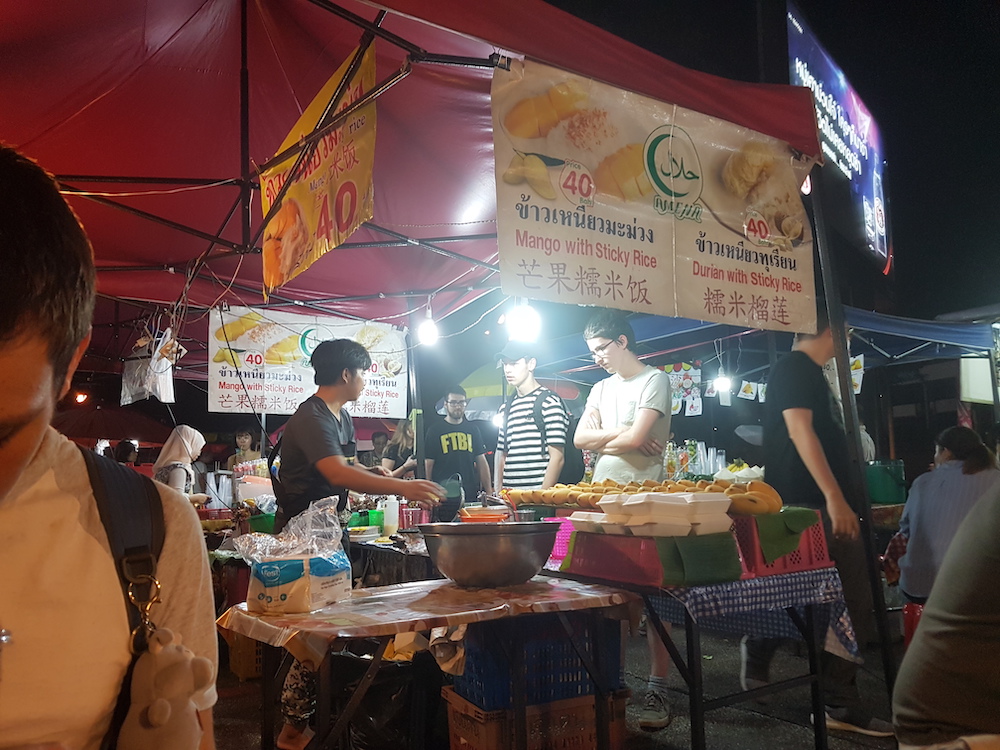
A night market in Chiang Mai
The restaurant was run by a little old man who seemed genuinely delighted that we’d come by, not just because we were tourists; there were plenty of those. I think it’s just part of their culture to be as welcoming and friendly as possible. The food was fantastic, fresh ingredients and a simple (perfected) recipe made for a really tasty meal. When I heard about a cooking class offering to teach the recipe along with a few other Thai dishes, I was all for it. The class was based on a farm outside the city and included a trip to a local market to find ingredients. We got on a bus that took us out to the countryside where we spent the whole day cooking, grinding up chillies and collecting fresh seasoning from the garden.
After the class we were all given cookbooks to take home and use for reference when attempting the recipes on our own, which was a nice touch. Although I’ll probably forget the recipes quite quickly, it was really interesting to learn about how Thai people think about food and the efforts they’ll go to in making it properly.
After a fair bit of research, I managed to get the elephant sanctuary booked online. You have to be really careful with elephant parks in Thailand as many of the holiday focussed tour groups aren’t treating their animals very ethically. Elephant riding is a big red flag for places like this. Despite their size, elephants’ backs aren’t very well equipped for too much extra weight, this makes prolonged riding by humans pretty damaging for them.
That said, there are still a number of groups which do treat the animals properly, so we went with one of those. Like our cooking class, the sanctuary was all the way out in the countryside, so we took a jeep to get there. After a long, bumpy ride, we arrived at the park. The elephant enclosure was pretty big so we couldn’t actually see any when we first arrived. Behind the feeding stalls was a wide green space with a river flowing through it and a forest leading up to the top of a hill.
Our guide informed us that the elephants would arrive on their own when it came to feeding time, in the meantime, we would go through the safety rules. We were each given a traditional poncho like vest with a little pocket to store bananas to feed the elephants with.
Before long, a lone elephant had appeared behind the river. We were told that this was the grandmother of the group and was now too old to climb the hill with the rest of them. She moved very slowly in our direction, followed a little while later by the rest of the group. As each elephant came into the view, our guide would give a short introduction for them, like a funny story or something about their character. It became apparent just how much they cared about them.
Among the herd was a baby elephant that they’d nicknamed “Naughty boy”. He was the favourite of the group and the other elephants were always looking out for him. They warned us that despite the fact he was a baby, he still weighed around 200kg. If he started to get a little too playful and decided to try rolling on us, it wasn’t going to end very well. We were also to watch out for when he got too excited as he’d start trumpeting and the rest of the group would run towards him. You really didn’t want to end up in the middle of that.
To gain the elephants’ trust and help them relax, we were given a few buckets of bananas to feed to them from behind a fence. You held a banana in the air, shouted “bonbon” and the elephant would reach out with its trunk and quickly grab it from your hand. It was a little intimidating at first as we were reminded that their muscular trunks could quite easily break an arm. But we soon got used to them, and they got used to us.
Once we ran out of bananas, our guides laid out some bamboo to keep the elephants occupied as we crossed the fence to go and meet them up close.
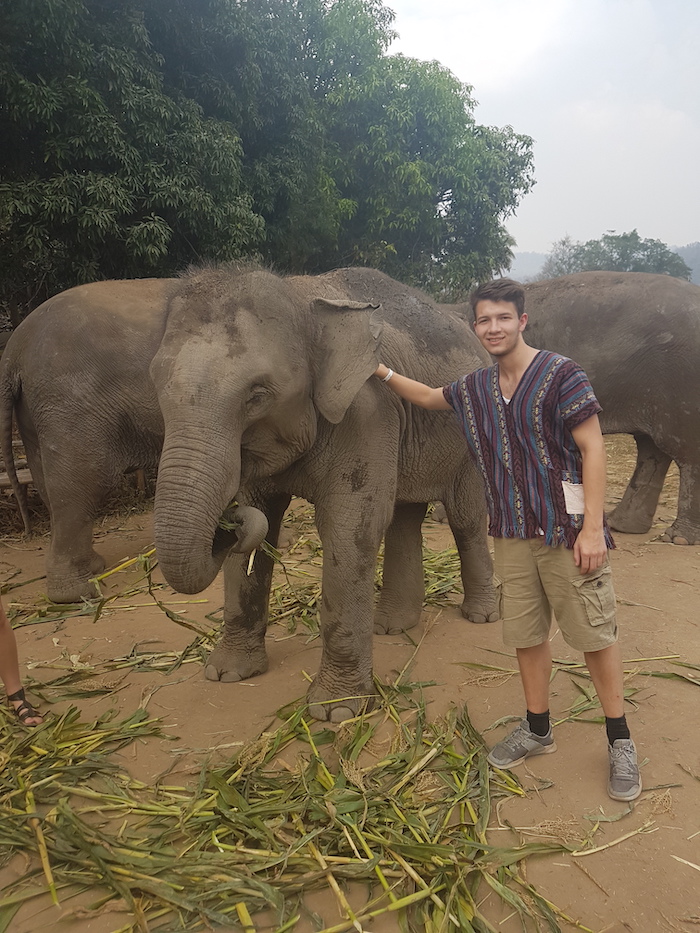
Meeting elephants in Chiang Mai
I don’t think I could quite describe what elephant skin really feels like. It’s dry, hairy, soft yet stiff, somewhere between the skin on your elbow, heavily worn leather and an old bit of mooring rope. They flapped their ears and felt around us with their trunks as we got some photos with them. Sometimes they would make this low rumbling noise, like a quad or tractor in the distance. Once the photographer had been around and taken photos of everybody with the elephants, we got changed so we could wash them (and help to do a quick health check).
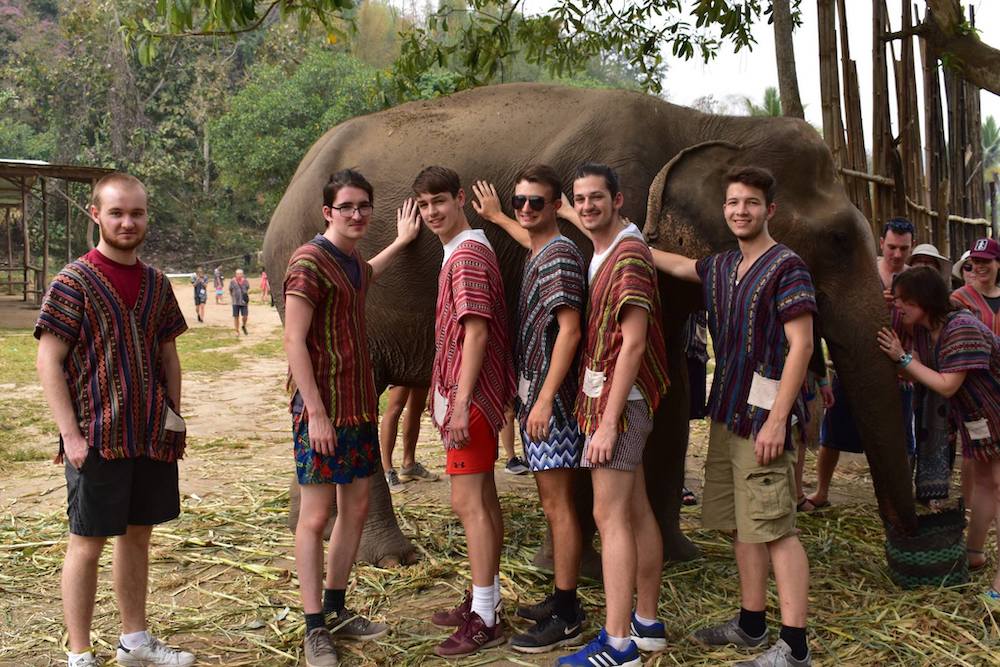
Charles wasn't so keen on the elephants
After that we took them for a mud bath, completely covering them in mud, before rinsing them off in the river. You could tell that the elephants were loving every second of it. It was a hot day so I imagine they were really enjoying cooling off in the water.
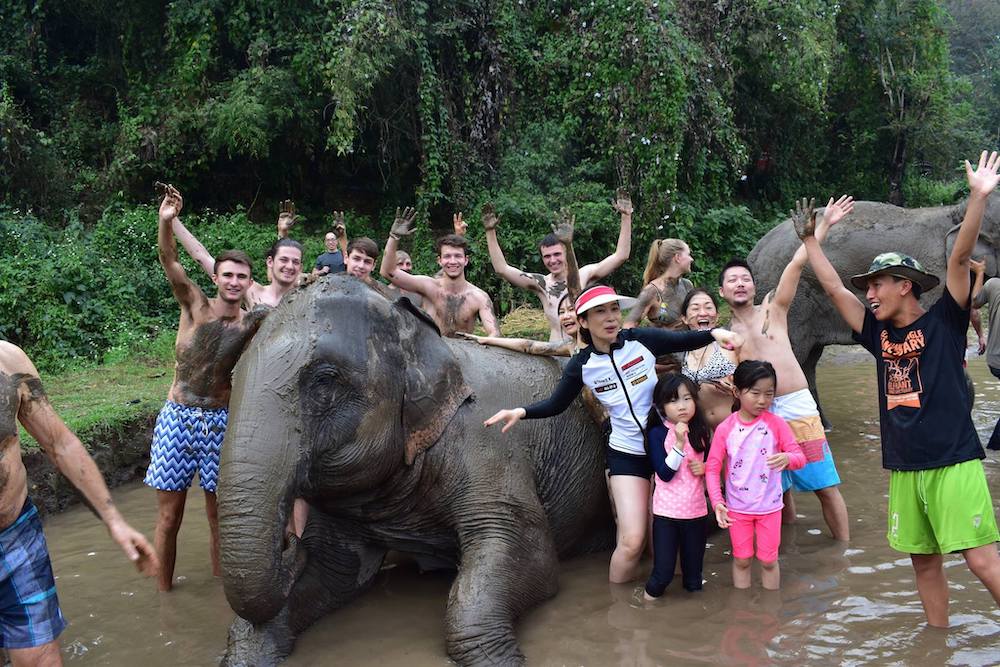
Giving the elephants a mud bath
We rode back to Chiang Mai in the jeep as the sun set. Just like with the whale sharks, I left the park with a whole new appreciation for the gentle giants having seen and felt them in real life. It was definitely one of the highlights of the trip.
Our final stop was Bangkok, Thailand’s capital in the South. We spent our time here a bit more relaxed, taking time to read, visit Buddhist temples and go for walks around the city as our holiday drew to a close.
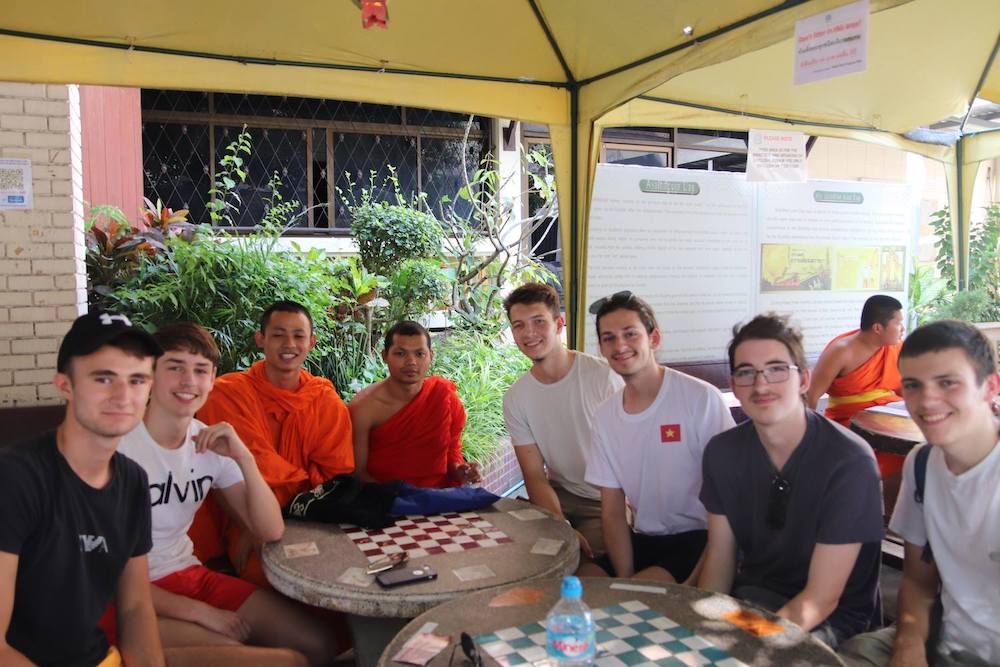
Meeting some monks at a temple in Chiang Mai
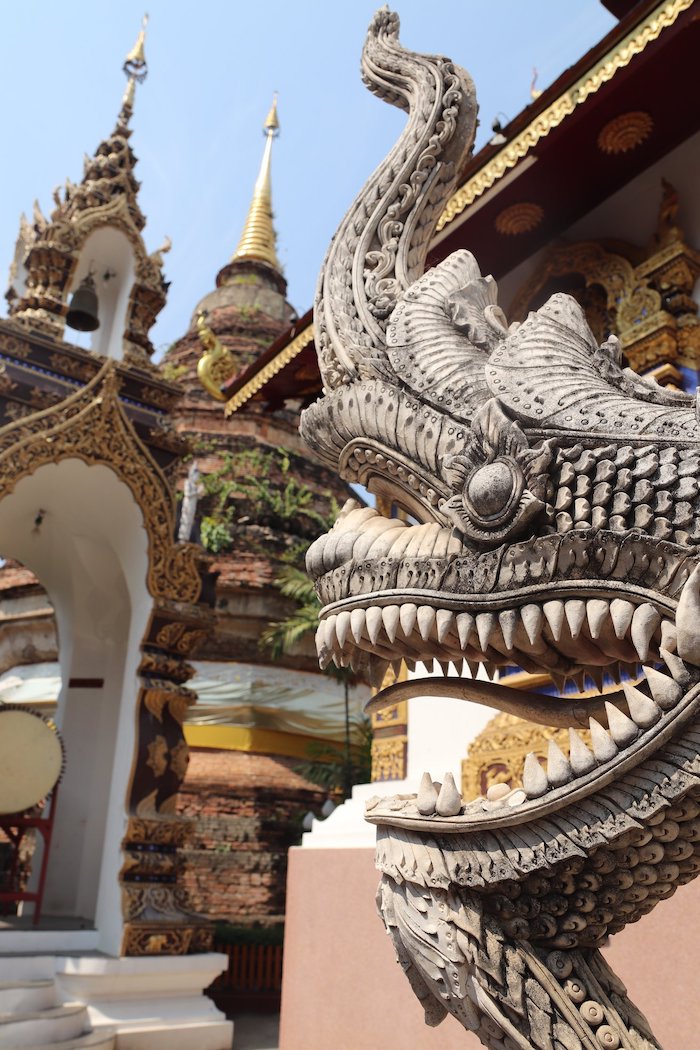
Dragon statues at a temple in Chiang Mai
Sheldon at the Wat Doi Suthep temple in Chiang Mai
We arrived back in Tianjin just before the end of the month, with another few days before classes began again. We had a lot to look back on, having spent the last 5 weeks seeing and doing amazing things just about every day. There’s certainly a lot more I could talk about, but I think this blog might be going on a little (and I still have a couple more to write) so I’d better just leave it there. Hope you’ve enjoyed it, now onto March.
